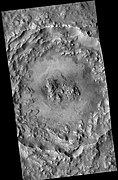奥基陨击坑
外观
奥基陨击坑(Auki)是火星第勒尼安海区的一座撞击坑,其中心坐标位于南纬15.76度、西经263.13度。它的直径约为40公里, 2015年,国际天文联合会(IAU)行星系统命名工作组(WGPSN)以所罗门群岛马莱塔省奥基市命名了它[1]。
奥基陨击坑坐落着一座中央峰,撞击坑通常有一圈被喷射物环绕的边缘,相比之下,火山坑通常没有边缘或喷射沉积物。当陨石坑越大(直径超过10公里)时,坑底中心通常就有一座中央峰[2],这种山峰是撞击后坑底地表反弹所形成[3]。
一组研究奥基陨击坑的研究人员报告了热液作用的有力证据,该陨坑中分布的山脊可能是在撞击产生的裂缝之后形成的。他们利用火星勘测轨道飞行器上的仪器发现了蒙脱石、二氧化硅、沸石、蛇纹石、碳酸盐以及在地球上撞击诱发的热液系统中常见的绿泥石等矿物[4][5][6][7][8][9] ,其他研究火星陨坑的科学家也提供了火星撞击后热液系统的另外证据[10][11][12]。
撞击会击碎岩石并产生大量可能持续数千年的热量[13],这种热量可以从热液循环中产生出新的矿物。地球上的撞击陨石坑曾产生了一些有用的矿物。地球上与撞击效应相关的矿石包括铁、铀、金、铜和镍等,据估计,仅在北美,从撞击构造中开采的矿料价值就高达50亿美元/年[14]。虽然在火星上尚未找到任何值得花费高昂成本向地球运送的东西,但未来的定居者从火星上获取的必要矿石越多,也就越容易在这颗红色星球上建立栖息地[15]。
-
显示奥基陨击坑与附近其他特征位置的地形图,颜色代表高程。
-
背景相机拍摄的奥基陨击坑全景图
-
高分辨率成像科学设备对奥基陨击坑中心部分的近距离观察,箭头指示了山脊线,沙丘出现在图像顶部附近。
-
上一幅高分辨率山脊图像的近视图,箭头指示了一处“X”形山脊线。
-
奥基陨击坑中央部分近视图,显示了箭头指示的山脊,这是前一幅高分辨率成像科学设备所拍摄图像的放大版。
另请查阅
[编辑]参引资料
[编辑]- ^ "奥基陨击坑". Gazetteer of Planetary Nomenclature. USGS Astrogeology Research Program.
- ^ 存档副本. [2021-08-18]. (原始内容存档于2016-01-14).
- ^ Hugh H. Kieffer. Mars. University of Arizona Press. 1992 [7 March 2011]. ISBN 978-0-8165-1257-7. (原始内容存档于2017-03-12).
- ^ Carrozzo, F. et al. 2017. Geology and mineralogy of the Auki Crater, Tyrrhena Terra, Mars: A possible post impact-induced hydrothermal system. 281: 228-239
- ^ Loizeau, D. et al. 2012. Characterization of hydrated silicate-bearing outcrops in tyrrhena Terra, Mars: implications to the alteration history of Mars. Icarus: 219, 476-497.
- ^ Naumov, M. 2005. Principal features of impact-generated hydrothermal circulation systems: mineralogical and geochemical evidence. Geofluids: 5, 165-184.
- ^ Ehlmann, B., et al. 2011. Evidence for low-grade metamorphism, hydrothermal alteration, and diagenesis on Mars from phyllosilicate mineral assemblages. Clays Clay Miner: 59, 359-377.
- ^ Osinski, G. et al. 2013. Impact-generated hydrothermal systems on Earth and Mars. Icarus: 224, 347-363.
- ^ Schwenzer, S., D. Kring. 2013. Alteration minerals in impact-generated hydrothermal systems – Exploring host rock variability. Icarus: 226, 487-496.
- ^ Marzo, G., et al. 2010 Evidence for hesperian impact-induced hydrothermalism on Mars. Icarus: 667-683.
- ^ Mangold, N., et al. 2012 Hydrothermal alteration in a late hesperian impact crater on Mars. 43rd Lunar and Planetary Science. #1209.
- ^ Tornabene, L., et al. 2009. Parautochthonous megabreccias and possible evidence of impact-induced hydrothermal alteration in holden crater, Mars. 40th LPSC. #1766.
- ^ Dohm, J.; Hare, T.; Robbins, S.; Williams, J.-P.; Soare, R.; El-Maarry, M.; Conway, S.; Buczkowski, D.; Kargel, J.; Banks, M.; Fairén, A.; Schulze-Makuch, D.; Komatsu, G.; Miyamoto, H.; Anderson, R.; Davila, A.; Mahaney, W.; Fink, W.; Cleaves, H.; Yan, J.; Hynek, B.; Maruyama, S. (2015). "Geological and hydrological histories of the Argyre province, Mars". Icarus. 253: 66–98. Bibcode:2015Icar..253...66D. doi:10.1016/j.icarus.2015.02.017.
- ^ Grieve, R., V. Masaitis. 1994. The Economic Potential of Terrestrial Impact Craters. International Geology Review: 36, 105-151.
- ^ Larry O'Hanlon. Mining Mars? Where's the Ore?. Discovery News. February 22, 2010 [2021-08-18]. (原始内容存档于2012-10-22).
推荐阅读
[编辑]- Lorenz, R. 2014. The Dune Whisperers. The Planetary Report: 34, 1, 8-14





